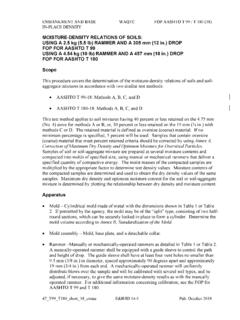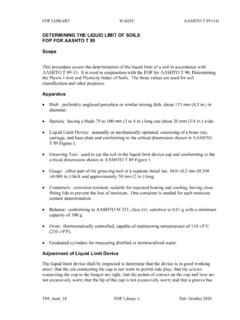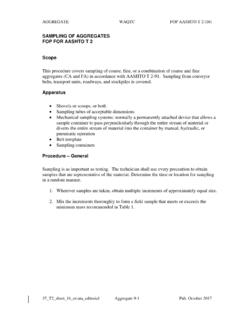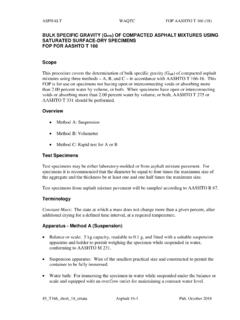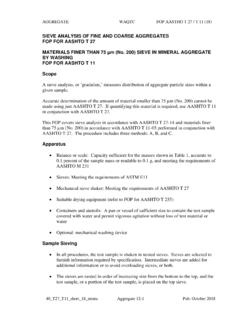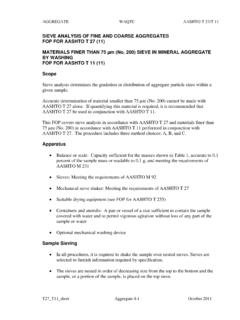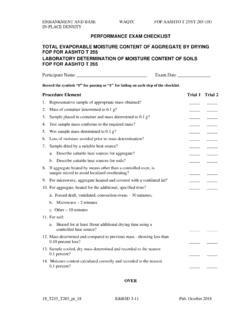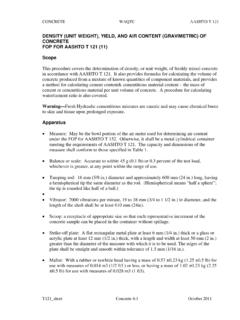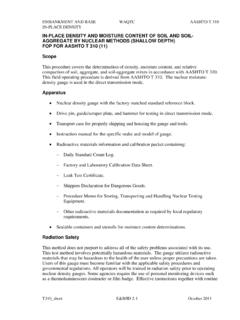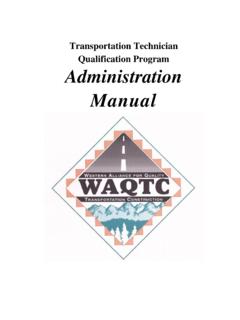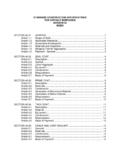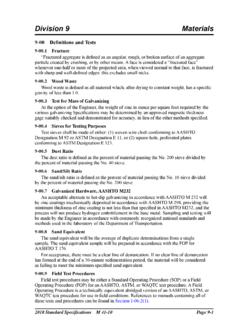Transcription of METHOD OF MAKING AND CURING CONCRETE …
1 CONCRETE waqtc AASHTO T 23 T23_short CONCRETE 6-1 October 2011 METHOD OF MAKING AND CURING CONCRETE TEST SPECIMENS IN THE FIELD FOP FOR AASHTO T 23 (11) Scope This procedure covers the METHOD for MAKING , initially CURING , and transporting CONCRETE test specimens in the field in accordance with AASHTO T 23. Warning Fresh Hydraulic cementitious mixtures are caustic and may cause chemical burns to skin and tissue upon prolonged exposure. Apparatus and Test Specimens CONCRETE cylinder molds: Conforming to AASHTO M 205 with a length equal to twice the diameter. Standard specimens shall be 150 mm (6 in.) by 300 mm (12 in.) cylinders. Mold diameter must be at least three times the maximum aggregate size unless wet sieving is conducted according to the FOP for waqtc TM 2.
2 Agency specifications may allow cylinder molds of 100 mm (4 in.) by 200 mm (8 in.) when the nominal maximum aggregate size does not exceed 25 mm (1 in.). Beam molds: Rectangular in shape with ends and sides at right angles to each other. Must be sufficiently rigid to resist warpage. Surfaces must be smooth. Molds shall produce length no more than mm (1/16 ) shorter than that required (greater length is allowed). Maximum variation from nominal cross section shall not exceed mm (1/8 in.). Ratio of width to depth may not exceed 1:5; the smaller dimension must be at least 3 times the maximum aggregate size. Unless otherwise noted in specifications, beam molds for casting specimens in the field shall result in specimens having width and depth of not less than 150 mm (6 inches).
3 Specimens shall be cast and hardened with the long axes horizontal. Standard tamping rod: 16 mm (5/8 in.) in diameter and approximately 600 mm (24 in.) long, having a hemispherical tip of the same diameter as the rod for preparing 150mm (6 in.) x 300 mm (12 in.) cylinders. Small tamping rod: 10 mm (3/8 in.) diameter and approximately 305 mm (12 in.) long, having a hemispherical tip of the same diameter as the rod for preparing 100 mm (4 in.) x 200 mm (8 in.) cylinders. Vibrator: At least 7000 vibrations per minute, with a diameter no more than the diameter or width of the mold and at least 75 mm (3 in.) longer than the section being vibrated for use with low slump CONCRETE . Scoop: a receptacle of appropriate size so that each representative increment of the CONCRETE sample can be placed in the container without spillage.
4 Trowel or float Mallet: With a rubber or rawhide head having a mass of kg ( lb.). Rigid base plates and cover plates: may be metal, glass, or plywood. CONCRETE waqtc AASHTO T 23 T23_short CONCRETE 6-2 October 2011 Initial CURING facilities: Temperature-controlled CURING box or enclosure capable of maintaining the required range of 16 to 27 C (60 to 80 F) during the entire initial CURING period (for CONCRETE with compressive strength of 40 Mpa (6000 psi) or more, the temperature shall be 20 to 26 C (68 to 78 F). As an alternative, sand or earth for initial cylinder protection may be used provided that the required temperature range is maintained and the specimens are not damaged. Thermometer: Capable of registering both maximum and minimum temperatures during the initial cure.)
5 Procedure MAKING Specimens General 1. Obtain the sample according to the FOP for waqtc TM 2. 2. Wet Sieving per the FOP for waqtc TM 2 is required for 150 mm (6 in.) diameter specimens containing aggregate with a nominal maximum size greater than 50 mm (2 in.); screen the sample over the 50 mm (2 in.) sieve. 3. Remix the sample after transporting to testing location. 4. Begin MAKING specimens within 15 minutes of obtaining the sample. 5. Set molds upright on a level, rigid base in a location free from vibration and relatively close to where they will be stored. 6. Fill molds in the required number of layers, attempting to slightly overfill the mold on the final layer. Add or remove CONCRETE prior to completion of consolidation to avoid a deficiency or excess of CONCRETE .
6 7. There are two methods of consolidating the CONCRETE rodding and internal vibration. If the slump is greater than 25 mm (1 in.), consolidation may be by rodding or vibration. When the slump is 25 mm (1 in.) or less, consolidate the sample by internal vibration. Agency specifications may dictate when rodding or vibration will be used. Procedure MAKING Cylinders Rodding 1. For the standard 150 mm (6 in.) by 300 mm (12 in.) specimen , fill each mold in three approximately equal layers, moving the scoop or trowel around the perimeter of the mold to evenly distribute the CONCRETE . For the 100 mm (4 in.) by 200 mm (8 in.) specimen , fill the mold in two layers. When filling the final layer, slightly overfill the mold.
7 2. Consolidate each layer with 25 strokes of the appropriate tamping rod, using the rounded end. Distribute strokes evenly over the cross section of the CONCRETE . Rod the first layer throughout its depth without forcibly hitting the bottom. For subsequent layers, rod the layer throughout its depth penetrating approximately 25 mm (1 in.) into the underlying layer. 3. After rodding each layer, tap the sides of each mold 10 to 15 times with the mallet (reusable steel molds) or lightly with the open hand (single-use light-gauge molds). 4. Strike off the surface of the molds with tamping rod or straightedge and begin initial CURING . Note 1: Floating or troweling is permitted instead of striking off with rod or straightedge. CONCRETE waqtc AASHTO T 23 T23_short CONCRETE 6-3 October 2011 Procedure MAKING Cylinders Internal Vibration 1.
8 Fill the mold in two layers. 2. Insert the vibrator at the required number of different points for each layer (two points for 150 mm (6 in.) diameter cylinders; one point for 100 mm (4 in.) diameter cylinders). When vibrating the bottom layer, do not let the vibrator touch the bottom or sides of the mold. When vibrating the top layer, the vibrator shall penetrate into the underlying layer approximately 25 mm (1 in.) 3. Remove the vibrator slowly, so that no large air pockets are left in the material. Note 2: Continue vibration only long enough to achieve proper consolidation of the CONCRETE . Over vibration may cause segregation and loss of appreciable quantities of intentionally entrained air. 4. After vibrating each layer, tap the sides of each mold 10 to 15 times with the mallet (reusable steel molds) or lightly with the open hand (single-use light-gauge molds).
9 5. Strike off the surface of the molds with tamping rod or straightedge and begin initial CURING . Procedure MAKING Flexural Beams Rodding 1. Fill the mold in two approximately equal layers with the second layer slightly overfilling the mold. 2. Consolidate each layer with the tamping rod once for every 1300 mm2 (2 in2) using the rounded end. Rod each layer throughout its depth, taking care to not forcibly strike the bottom of the mold when compacting the first layer. Rod the second layer throughout its depth, penetrating approximately 25 mm (1 ) into the lower layer. 3. After rodding each layer, strike the mold 10 to 15 times with the mallet and spade along the sides and end using a trowel. 4. Strike off to a flat surface using a float or trowel and begin initial CURING .
10 Procedure MAKING Flexural Beams Vibration 1. Fill the mold to overflowing in one layer. 2. Consolidate the CONCRETE by inserting the vibrator vertically along the centerline at intervals not exceeding 150 mm (6 in.). Take care to not over-vibrate, and withdraw the vibrator slowly to avoid large voids. Do not contact the bottom or sides of the mold with the vibrator. 3. After vibrating, strike the mold 10 to 15 times with the mallet. 4. Strike off to a flat surface using a float or trowel and begin initial CURING . Procedure Initial CURING When moving cylinder specimens made with single use molds support the bottom of the mold with trowel, hand, or other device. CONCRETE waqtc AASHTO T 23 T23_short CONCRETE 6-4 October 2011 For initial CURING of cylinders, there are two methods, use of which depends on the agency.
